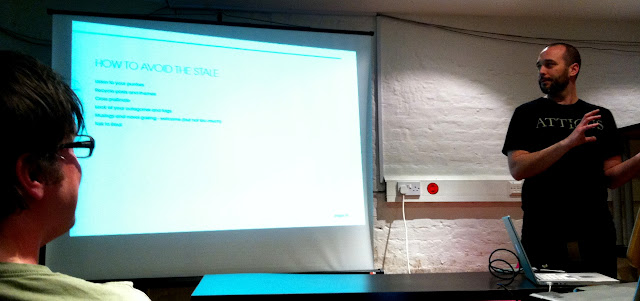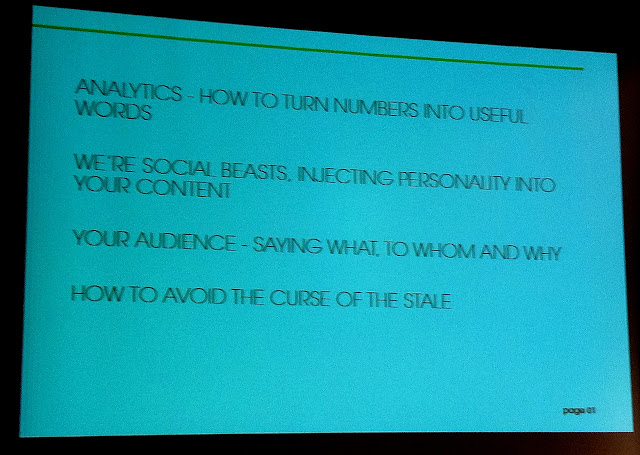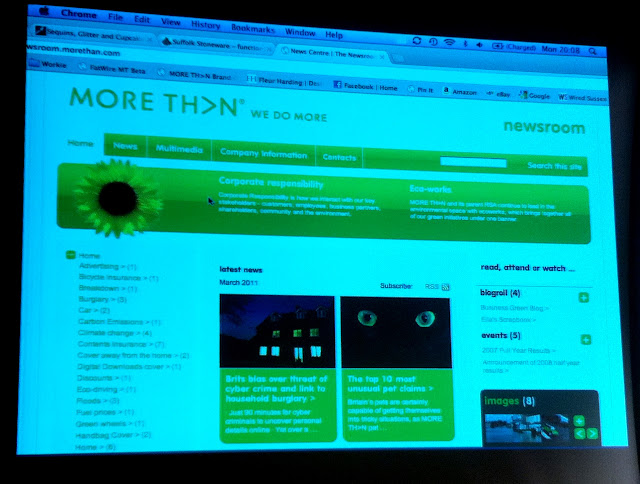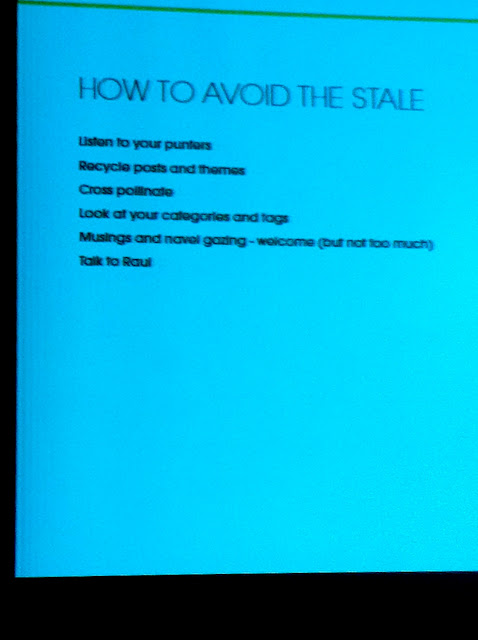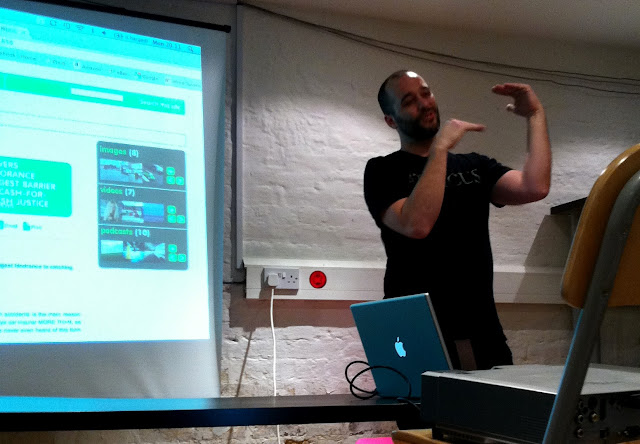Home » E-marketing
Category Archives: E-marketing
Covering Student End of Year Shows in 360

Continuing coverage of the summer at GB MET show at Durrington.
The pattern that is emerging is to cover the ground, each exhibition room and some corridors with a 360 still image, then return to take mid-shots and extreme close-ups. As I find the language for covering an exhibition I also use 360 video.
The pattern is to cover a room, on the self-timer at 5 to 10 seconds, then return first with a standard lens and then using a close-up lens for fine detail. Everything is manually set to try and negotiate very different lighting conditions. Much of the lighting is mixed source, between bright, low or no sunlight, with neon or other artificial lighting. The 360 camera offers various White Balance settings. Shutter speeds are generally kept low so that if someone wanders into a shot (rare) they will be out of focus in any case. Exposure is therefore adjusted by the ISO.
All the images using the standard digital camera are RAW.
All the 360 images are transferred to an iPad mini which operates the 360 camera remotely. All the images on the iPad are backed up in Google Photos. All these images, those chosen to use at least, will then be colour corrected in Adobe Lightroom, then uploaded into ThingLink and stitched together into a Virtual Reality Tour.
Some ‘establishing shots’ or just reminders of the rooms or corridors I am in are shot on my iPhone. It might be better to use the iPad for these and keep the images saved on a college device and in my college Google Gallery.
‘Hotspots’ will feature a random mixture of mid-shots and close-ups. The issue with VR is that the ability to zoom is lost as soon as you overlay ‘tags’ and ‘hot spots’ and the definition is reduced with the zoom too which counters the way we step in to take a closer look to see greater detail, not to have it obscured.
The coverage is somewhat random as I am not in position either to be comprehensive (cover all items in all sizes) or to be selective (I don’t know the student, the tutor or the department).
The simplest guidance I get is to cover the Degree graduate programme. Armed with a plan of the site I pick all of these off over two days. The Richoh Theta 360 camera runs for around 6 hours, but can overheat and shut down. It takes 4 hours to charge. At times a second 360 camera would be handy. With the self-timer I can get well-out of shot though I have learnt to leave the iPad within a 4m range so that the link is not lost. Once activates the camera will still take a picture however once lost the signal has to be reset via the WiFi connection, or sometimes by turning the camera on and off again.
Web Networks – from the micro to the macro
We are each unique – our brains make us so. At the microlevel the network in our heads is then tickled out into the the Web in, at first. the simplest of ways. Our first post, our first comment is that first baby-step. Unlike our firsf steps though, online everything we do is saved, is monitored, is shared. It takes on a life of its own. Multiplied billions of times now many millions of us have learnt to crawl, then walk, then run online. As we are virtual we can split into many versions or parts of ourselves too – the professional and private the immediate split, but then into hobby groups and as here, a study group. The network of networks is a living thing that mathematics can help to weight and categorize, even to visualise, but crucially – the point made here, humanising the maths requires the insight of someone asking questions, seeking to interpret what it taking place. I see currents in a digital ocean that transpires into a cloud that then precipitates digital artefacts in a myriad of other places. Others, like Yrjo Engegstrom, see the growing tendrils of a funghi. Either way it is fascinating to condense, simplify and sharing the thinking.
Getting more than you’d expect from WordPress.
An evening in the Lanes at the Skiff.
This is Silicon Valley on the south coast of England. This was a Word Up.
Chris Harding from ‘More Than’ and memorial headstones insurance.
I’ve missed all of this, the casual, bright and open vibrancy of Brighton. Where else in on a Tuesday night do get beer, cake and good crack while talking shop?
Never in Milton Keynes.
Chris used a great analogy on bike riding with all kinds of sensors.
He monitors his performance when road racing to deal with the boredom and to understand what the training is doing for him. His joy is Mountain Bike riding. Without analytics you don’t know a blog’s performance.
Set some KPIs before you start.
Yoast plugin
Clicktale – add in WordPress
NB unique visitors
Referrers
Dwell time now down to 5 seconds
Page impressions – eyes on a page
Bounce rate people leaving within 10 seconds
Keep key content above the fold to disclose as much as possible in the first 250 words.
Find out what people are saying
Reciprocal feedback
Fill yourself in slowly
Like at pub
Weave them in gently
Find niche for yourself
It is very much like a play
Hejaz a degree in theatre
Persona profiling
Real or people you have made up.
When you are writing a piece of content bare them in mind.
Translation packages for WordPress
How to avoid the stale
Recycle posts
Information arch
All in WordPress SEO pack
Use inbound writer
Re Resolving and Google
Your content is you currency
Video, Copy, Social Media and Creative Communications
Eyes & Ears campaign. Encouraging corporate responsibility and reporting incidents and events. Video, Events, Regional TV & Press.
I love what I do and from every angle want to be an effective communicator blending intelligence and ideas with video and social media to get the job done. It’s become akin to live theatre: you can measure success or failings with bums on seats, their applause or otherwise, comments, feedback and participation.
If they’re with you they’ll even do the job for you, spreading the good word and generating compelling content.
My response to this? Don’t get in their way! Can this be intellectualised?
Yes.
Not only can everything be taught, but cause and effect should be analysed and written up so that through reflection and sharing with colleges you learn to improve and adapt the narrative of your actions.
As well as an OU MBA module ‘Creativity, Innovation & Change’, I’ve just signed up to an online social media course with MMC Learning.
I have one more module to gain an MA in Open & Distance Learning too; why this? Because learning is an effect, it demonstrates an ability to pass on and develop skills, ideas and knowledge.
Because we can’t help ourselves, it’s how we humans progress.
The day job, studying and 8-12 hours online: how do I do it? It makes me tick. A decade ago I shared a thought in my blog, suggesting that I kept a diary, journal, log, blog, photo journal, scrap book, garage full of junk in order to prove that I am alive (that I was here).
If I can be harnessed to a good cause and earn a living from it too, all the better.
6 Types of Learning
Six different types of learning
‘Categories of Activity’
1) Behaviourist-type
2) Constructivist
3) Situated
4) Collaborative
5) Informal and lifelong
6) Support or coordination
Spontaneous communication and collaboration, e.g. one-to-one or one-to-may by texting or mobile phones, by sending a message to a forum or blog while travelling.
e.g. Childhood journeys. Taking octogenarians home through mobile devices.
REFERENCE
Naismith, L., Lonsdale, P., Vavoula, G. and Sharples, M. (2004) Literature Review in Mobile Technologies and Learning, Report 11 for Futurelab. Online. Available.
Linkedin to the FT
Sounds like a plug? It isn’t meant to be, but it’s the phrase that comes to mind.
Spotting that the FT had a blog roll of student MBAs I was concerned that there was no one fom the Open University. Reading through the OU Blogs I found a link to Sean Brady. I’ve had fellow students who are in the services; they are reliable bloggers. I wonder if it acts as evidence of their learning and the investment in them by the MOD?
Anyway, I left Sean a comment, then looked for him in Linkedin; I’m impatient. I then sent him a message.
We got in touch, discused the idea and I approach the FT.
Spam spam spam spam spam spam spam spam spam spam spam!
Is there a difference between nuisance spam and illegal spam?
You should consider this while watching the Monty Python Spam sketch set to Lego animation
Rather like between fly tipping and dropping litter? is it simply a matter of scale … And being caught in an ocean of digital activity?

